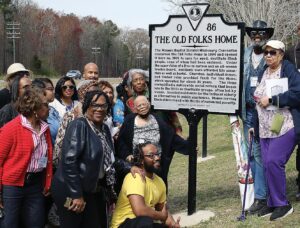
Some descendants of the founding trustees of the “Old Folks Home” in Ozeana pose for photos following the unveiling of a historical highway marker on March 29.
A slice of Essex County’s African American heritage was celebrated Saturday afternoon.
More than 100 people gathered under a tent on the grounds of the former Rappahannock Industrial Academy site to celebrate the unveiling of a highway marker recognizing The Old Folks Home that operated on the property for around three decades during the early 20th century.
The Woman’s Baptist District Missionary Convention opened The Old Folks Home in Essex County circa 1909 to provide care for impoverished elderly Black people, some of whom had been enslaved.
Several organizations and individuals were responsible for Saturday’s event including the Middle Peninsula African american Genealogical and Historical Society Highway Marker Research Team and the Angel Visit Baptist Church History Ministry, and the Southside Rappahannock Baptist Association. Among the individuals recognized for their service included the Rev. Dr. Gene Quarles, the Rev. Fred D. Holmes Jr., the Rev. Dr. Barbara A.F. Brehon, and Bessida Cauthorne White who chaired the Old Folks Home Highway Marker Initiative.
“It’s been an absolutely glorious day,” White told the Rappahannock Times following the marker’s unveiling. “We know the ancestors are smiling and all of their descendants as well. We are all delighted.”
Essex resident Rosa Wheeler Cauthorne (1865-1931) of Ozeana was one of the founding trustees of the Old Folks Home. Other founding trustees were Martha Ellis Braxton (1875-1918) of Lancaster, Sally Page Gaines (1856-1956) of Walkerton, Mary Ann Harris (1865- 1945) of Urbanna, Mattie Gatewood McGill (1875- 1932) of Church View, Mary Eliza Cook Moody (1874- 1937) of Jamaica, and Susan A. Jackson Smith (1863- 1941) of Gloucester.
Subsequent trustees of the Old Folks Home included Essex resident Ida Smith Cauthorne (1884-1965) of Ozeana, Naomi Harris Dabney (1888-1967) of Fredericksburg, Mary Payne Harris (1875-1944) of Harmony Village, Mary Brook Jones (1888-1990) of Indian Neck, Fannie Smith Turner ((1886- 1947) of West Point, and Williana Stewart Williams (1876-1961) of Little Plymouth.
Essex residents Ida Wheeler Bayton (1859-1931) and Etta Shelton Cauthorne (1881- 1950), both of Ozeana, served as live-in matrons at the Old Folks Home.
Essex Board of Supervisors Vice Chairman Ronnie G. Gill presented the Rev. Dr. Carla E. Lightfoot, moderator of the Southside Rappahannock Baptist Association and pastor of Angel Visit Baptist Church, with a proclamation recognizing March 29 as “Old Folks Home Day” in Essex County.
During the ceremony, remarks were made by the Rev. Dr. Maurice Dabney Finney (pastor of St. Andrews Baptist Church in Cullen and Aspen Hill Baptist Church in Brookneal), Cherie Harris (president of the Southside Rappahannock Baptist Association Women’s Ministry), the Rev. Dr. Griselda Amy Bayton (first vice president, Baptist General Convention of Virginia and pastor of Trinity Baptist Church in Center Cross), the Rev. Dr. Leonard L. Edloe (pastor, New Hope Fellowship in Hartfield), and Martin Townes, member of the Virginia Board of Historic Resources.
A Pouring of Libation Ceremony was performed by the Rev. Dr. Ella Haris Johnson (second vice moderator of the Southside Rappahannock Baptist Association and assistant pastor at Good Hope Baptist Church in Dunnsville) and Aleandria Hunt- Quarles (president, State Youth Ministry, Baptist General Convention of Virginia.
A musical selection was performed by Deacon Gina R. McGuire, and the Rev. Brehon (associate pastor of Beulah Baptist Church, Minor, and immediate past moderator, Southside Rappahannock Baptist Association) presided over the benediction and grace.
Afterward, descendants of the founding Old Folks Home trustees participated in the marker’s unveiling and posed for photographs.
The text of the highway marker reads:
The Old Folks Home
The Woman’s Baptist District Missionary Convention conceived the Old Folks Home in 1894 and opened it here ca. 1909 to care for aged, destitute Black people, some of whom had been enslaved. Under the supervision of a live-in matron and an all-woman trustee board, residents were afforded life essentials as well as burial. Churches, individual donors, and timber sales provided funds for the Home, which operated for about 30 years. The Home exemplified a nationwide social reform that began late in the 1800s as charitable groups, often led by women, founded residences for the indigent elderly as alternatives to public almshouses. Homes serving Black elders coped with the ills of racism and poverty.
See photos from Saturday’s celebration on page A10.

Loading Comments